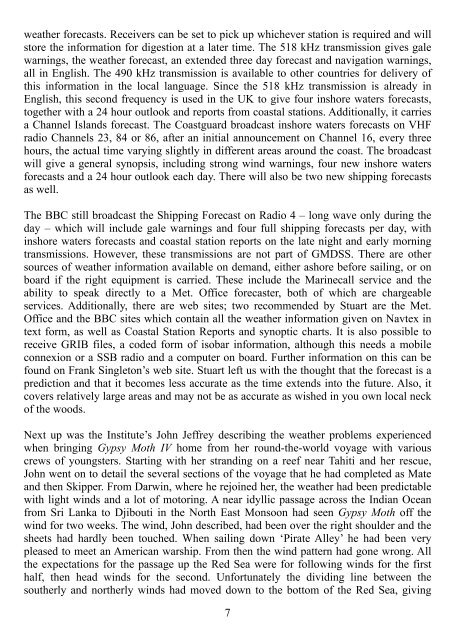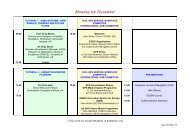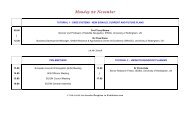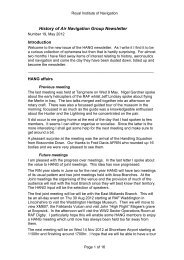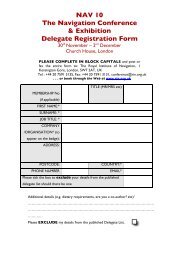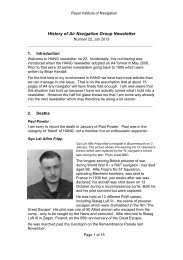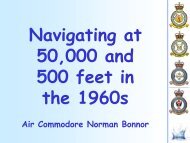Fairway 30 - Royal Institute of Navigation
Fairway 30 - Royal Institute of Navigation
Fairway 30 - Royal Institute of Navigation
You also want an ePaper? Increase the reach of your titles
YUMPU automatically turns print PDFs into web optimized ePapers that Google loves.
weather forecasts. Receivers can be set to pick up whichever station is required and will<br />
store the information for digestion at a later time. The 518 kHz transmission gives gale<br />
warnings, the weather forecast, an extended three day forecast and navigation warnings,<br />
all in English. The 490 kHz transmission is available to other countries for delivery <strong>of</strong><br />
this information in the local language. Since the 518 kHz transmission is already in<br />
English, this second frequency is used in the UK to give four inshore waters forecasts,<br />
together with a 24 hour outlook and reports from coastal stations. Additionally, it carries<br />
a Channel Islands forecast. The Coastguard broadcast inshore waters forecasts on VHF<br />
radio Channels 23, 84 or 86, after an initial announcement on Channel 16, every three<br />
hours, the actual time varying slightly in different areas around the coast. The broadcast<br />
will give a general synopsis, including strong wind warnings, four new inshore waters<br />
forecasts and a 24 hour outlook each day. There will also be two new shipping forecasts<br />
as well.<br />
The BBC still broadcast the Shipping Forecast on Radio 4 – long wave only during the<br />
day – which will include gale warnings and four full shipping forecasts per day, with<br />
inshore waters forecasts and coastal station reports on the late night and early morning<br />
transmissions. However, these transmissions are not part <strong>of</strong> GMDSS. There are other<br />
sources <strong>of</strong> weather information available on demand, either ashore before sailing, or on<br />
board if the right equipment is carried. These include the Marinecall service and the<br />
ability to speak directly to a Met. Office forecaster, both <strong>of</strong> which are chargeable<br />
services. Additionally, there are web sites; two recommended by Stuart are the Met.<br />
Office and the BBC sites which contain all the weather information given on Navtex in<br />
text form, as well as Coastal Station Reports and synoptic charts. It is also possible to<br />
receive GRIB files, a coded form <strong>of</strong> isobar information, although this needs a mobile<br />
connexion or a SSB radio and a computer on board. Further information on this can be<br />
found on Frank Singleton’s web site. Stuart left us with the thought that the forecast is a<br />
prediction and that it becomes less accurate as the time extends into the future. Also, it<br />
covers relatively large areas and may not be as accurate as wished in you own local neck<br />
<strong>of</strong> the woods.<br />
Next up was the <strong>Institute</strong>’s John Jeffrey describing the weather problems experienced<br />
when bringing Gypsy Moth IV home from her round-the-world voyage with various<br />
crews <strong>of</strong> youngsters. Starting with her stranding on a reef near Tahiti and her rescue,<br />
John went on to detail the several sections <strong>of</strong> the voyage that he had completed as Mate<br />
and then Skipper. From Darwin, where he rejoined her, the weather had been predictable<br />
with light winds and a lot <strong>of</strong> motoring. A near idyllic passage across the Indian Ocean<br />
from Sri Lanka to Djibouti in the North East Monsoon had seen Gypsy Moth <strong>of</strong>f the<br />
wind for two weeks. The wind, John described, had been over the right shoulder and the<br />
sheets had hardly been touched. When sailing down ‘Pirate Alley’ he had been very<br />
pleased to meet an American warship. From then the wind pattern had gone wrong. All<br />
the expectations for the passage up the Red Sea were for following winds for the first<br />
half, then head winds for the second. Unfortunately the dividing line between the<br />
southerly and northerly winds had moved down to the bottom <strong>of</strong> the Red Sea, giving<br />
7


